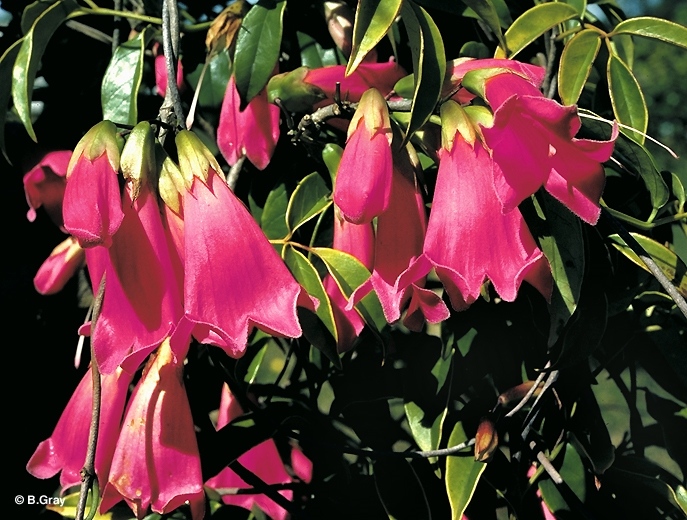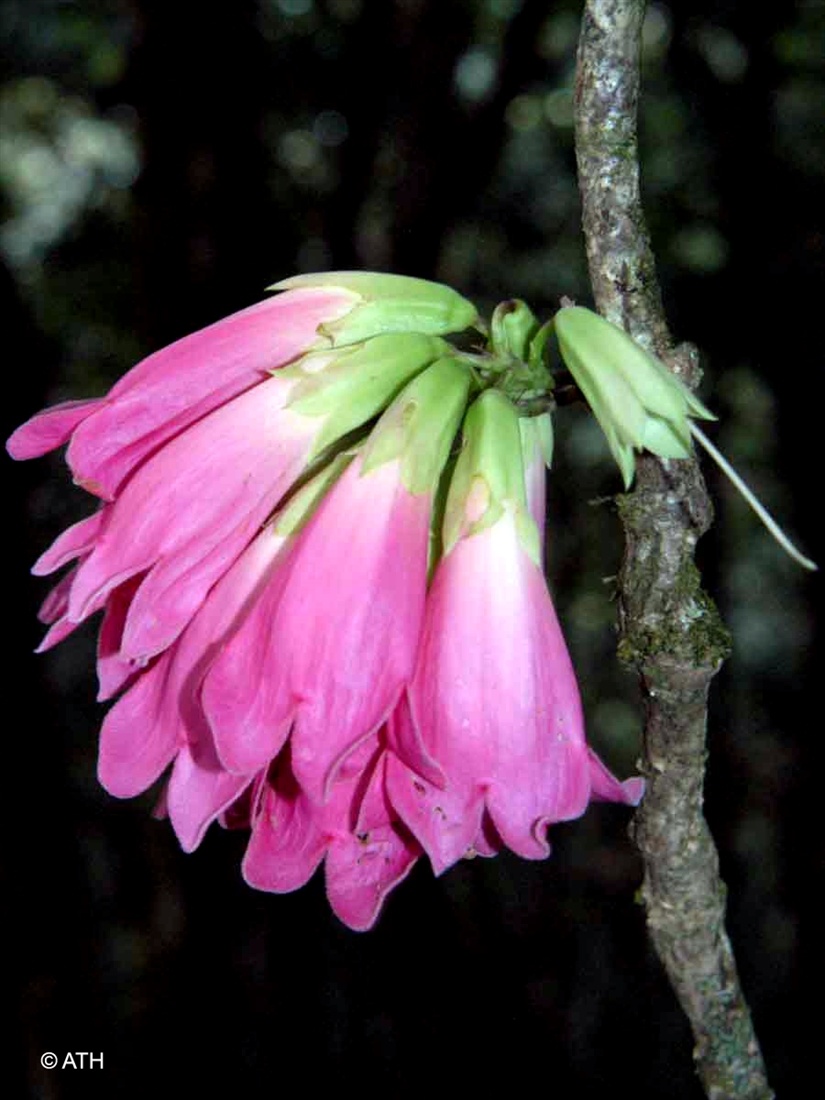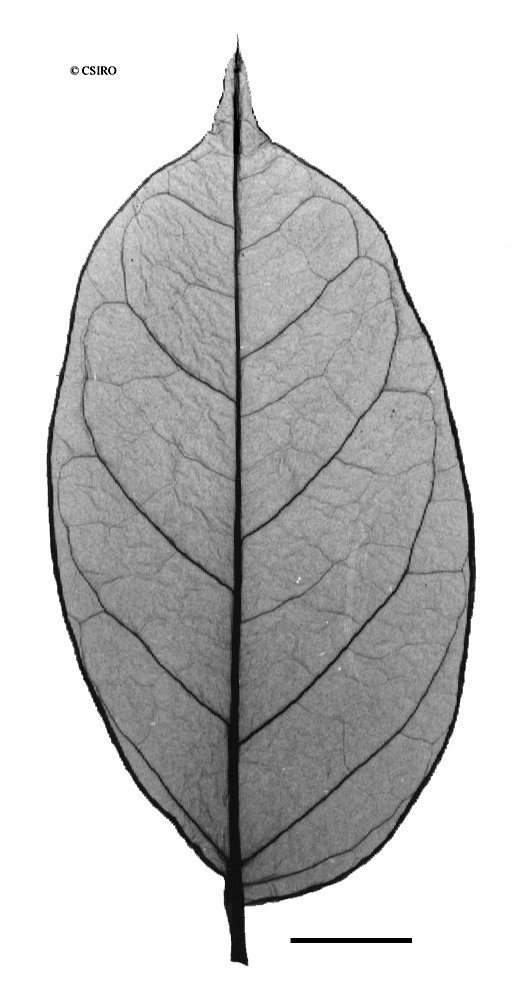Australian Tropical Rainforest Plants - Online edition
Tecomanthe burungu Zich & A.J.Ford






Zich, F. & Ford, A.J. (2018) Australian Systematic Botany 31(6): 481-486, Figs 1, 2. Type: "Queensland. COOK District: Timber Reserve 146, Tableland Logging Area [south of Cooktown], 9 Sep. 1980, B.Hyland 10566 (holo: BRI; iso: CNS (QRS61603), CANB)."
Canopy climber to 30 m. Branchlets to 3 cm diameter, terete, often twisted, bark grey or brownish, with sparse globular pale lenticels, glabrescent to glabrous except at leaf nodes where puberulous along a raised interpetiolar ridge, terminal bud puberulous initially.
Leaves opposite, trifoliolate or pinnate, and occasional leaflets bearing lobes or pinnules, petiole 20–70 mm long, grooved; leaflets usually 3–5, fleshy, discolorous, midvein slightly depressed on the adaxial surface and strongly raised on abaxial surface; 4–6 pairs of main lateral veins, strongly raised on abaxial surface; venation brochidodromous, tertiary veins usually scarcely discernible; lateral leaflets 55–97 mm long × 15–42 mm wide, margin entire to sparsely toothed distally, often undulate, ovate, elliptic to lanceolate, apex acute to acuminate, base obtuse to cuneate or truncate, base oblique, minutely puberulous and finely punctate glandular on abaxial surface, petiolule (0–)2–11 mm long, petiolule grooved on upper surface; terminal leaflets 58–112 mm long × 20–52 mm wide, margin entire to sparsely toothed distally, often undulate, ovate, elliptic to lanceolate, apex acute to acuminate, base obtuse to cuneate, sometimes oblique, minutely puberulous and finely punctate glandular on abaxial surface, petiolule 7–25 mm long, petiolule grooved on upper surface.
Inflorecence racemes usually axillary on leafless nodes of woody branchlets, ramiflorous or cauliflorous (rarely terminal and then associated with very short leafy twigs), to ca. 30 mm long; peduncle short, bracts lanceolate to linear, ca. 0.2–1.9 mm long; rachis 3–24 mm long, linear bracts subtending flowers 3–6 mm long. Flowers opposite, two per node; pedicels 6–19 mm; bracteoles 2.5–4.8 mm long, linear, paired near base of pedicel. Calyx infundibuliform (trumpet-shaped), with five more or less equal lobes, five midribs prominent from base of the calyx to the tip of the lobes on the adaxial surface, thin and herbaceous; 22–36 mm long from base to tip of lobes, pale green to pink-tinged; lobes erect, ovate-triangular, 6.5–12 mm long × 5–10 mm wide, shortly hairy near apex; apex cuspidate. Corolla 58–86 mm long, infundibuliform, asymmetrical, curved, pale to dark pink, paler at the base, throat cream to pale pink and darkening with age, with purple striations; lobes five, 12–14 mm long × 12–14 mm wide, apex bluntly pointed; tube 55–73 mm long, 24–33 mm diameter, glabrous outside, glabrous to sparsely hairy inside, glandular papillae and sometimes uniseriate hairs near insertion of stamens; lobes shortly hairy on both surfaces. Stamens 4, not exserted, curved, fused to corolla for 15–19 mm from base; two pairs of slightly unequal length, abaxial pair 37–43 mm, adaxial pair 30–35 mm; glabrous except near base where shortly uniseriate hairs present or absent, and glandular papillose hairs present; filaments filiform, anthers yellow, cells equal, 5–6 mm long × 2.5–3 mm wide, widely divergent. Staminode adaxial, fused to corolla for 16–25 mm from base, free length 14–20 (–23) mm, apex curved, at base with uniseriate hairs. Pollen shed in modads, tricoloporate, spheroid to ellipsoid, spheroid grains ca. 35 µm diamter, ellipsoid grain 18 x 45 to 25 x 60 µm, surface reticulate. Disk an annular ring. Style longer than stamens, included, 56–64 mm long, stigmas 2, sublanceolate. Ovary compressed, 2.4–5 mm long × 2.5 mm wide, glabrous.
Fruit a stipitate and beaked capsule, 138–180 mm long (from base of stipe) x 33 mm wide, valves smooth, woody, wide and boat shaped; seeds numerous, more or less orbicular and notched, 3.7 × 4.3 mm, with membranous wings 27 mm long × 12.7 mm wide; pedicel persistent, 15–17.6 mm long; calyx persistent.
Cotyledons about 9-11 x 11 mm, orbicular to wider than long, 2-lobed with a comparatively deep sinus at the apex. First pair of true leaves simple, with a few teeth. At the tenth leaf stage: leaf simple and lobed or pinnate with 3-5 leaflets, terminal leaflet larger then the lateral leaflets; leaf or leaflet margins with a few coarse teeth or lobes. Compound leaf rhachis and compound leaf petiole both narrowly winged.
Occurs in NEQ. Altitudinal range from near sea level to 1000 m. Grows in well developed lowland, upland and mountain rain forest.
This species has horticultural values and has been planted in gardens as it produces bunches of decorative tubular or bell-shaped flowers.





